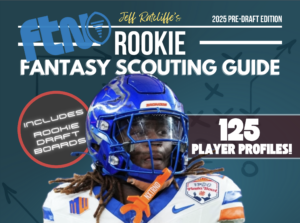
(All summer, Adam Pfeifer will be putting the tightest fantasy football picks under the microscope in our ADP Decisions series.)
The 2020 draft class was absolutely loaded. We know the receivers were historically good, but the running backs were outstanding as well.
The first two running backs selected in last year’s draft were Clyde Edwards-Helaire of the Chiefs and D’Andre Swift of the Lions, separated by just three selections. Fast forward to 2021 fantasy football drafts and both running backs are coming off the board fairly close to one another again, and while there are both concerns and things to love surrounding both rushers, which player should you target for your fantasy teams?
The case for Clyde Edwards-Helaire
Offseason hype can be very, very real.
That was especially the case with Edwards-Helaire this time last season. After the Chiefs selected him in the first round of the NFL Draft, fantasy players began to do the same, as CEH’s ADP skyrocketed toward the back end of the first round. After Week 1, it appeared that the rookie was going to live up to the hype, as Edwards-Helaire was the clear lead back for an elite offense, carrying the ball 25 times for 138 yards and a touchdown. Of course, because it was an island game, everyone was fixated on his inability to score from in close. Edwards-Helaire saw six carries from inside the 5-yard line against the Texans on opening night but failed to find the end zone on any of those totes. The Chiefs clearly changed their playcalling from inside the 10-yard line the rest of the season, as Edwards-Helaire, after those six carries inside the 5 in Week 1, saw only three such carries the rest of the way. It was frustrating, as he scored just five total touchdowns for the entire year, but heading into his sophomore season, there is a lot to like about CEH.

For starters, the Chiefs completely revamped their offensive line, adding Joe Thuney, Orlando Brown, Austin Blythe and Kyle Long during free agency, while drafting Creed Humphrey and Trey Smith. Kansas City was slightly below average in yards before contact per attempt last season (1.46), a number that should surely improve after the team upgraded their offensive line as much as they did. With the improvements they made, the Chiefs have the potential to be a top-five overall offensive line in football. Of course, we know the offense is going to be one of the best in football, which bodes extremely well for Edwards-Helaire. Playing alongside Patrick Mahomes, Travis Kelce and Tyreek Hill means that the running backs in this offense will see plenty of light fronts. In fact, according to FTN’s premium stats, the Chiefs ran the fewest plays with seven or more defenders in the box last season (118).
Given the offense and improvements to the line, I expect Edwards-Helaire to be fairly efficient on the ground. But I am also expecting more production as a pass-catcher in year two. Coming out of LSU, Edwards-Helaire was one of the best pass-catching running backs we’ve seen in a while. So it was surprising to see Darrel Williams playing in the two-minute drill and on third downs to start the season. Entering year two, I expect the Chiefs to give Edwards-Helaire more responsibilities in the passing game, especially with a more normal offseason under his belt, as well as three preseason games. And while the 36 receptions were underwhelming, CEH showed he can make plays with the ball in his hands. Despite missing three games, Edwards-Helaire finished seventh in football in missed tackles forced on receptions (13). After finishing 11th among all running backs in routes run (286), I think Edwards-Helaire could jump into the top six or seven in year two.
Getting 250 touches in this Kansas City offense is insanely valuable, especially assuming his touchdowns and goal-line usage both increase. This time last year, Edwards-Helaire was coming off the board as a late first round pick in fantasy drafts but now he’s a late-second/early-third round pick. However, he still has legitimate top-five upside in this offense and is a prime post-hype breakout candidate in 2021.
The case for D’Andre Swift
We often see rookie running backs get off to a slow start and then really pick up steam during the second half of the season. That was certainly the case with Swift in 2020.
Swift joined Kerryon Johnson and Adrian Peterson to form a committee during his rookie year, which limited him to just 114 carries. However, the efficiency was strong, as Swift averaged 4.6 yards per carry and scored eight rushing touchdowns. Coming out of Georgia, Swift was a fantastic pass-catcher and that translated to the NFL, as he ranked seventh among running backs in yards per route run (1.58), while his 56 targets were the 12th-most at the position. Swift missed Weeks 11-14 with a concussion/illness, but if you take the nine games he was active in from Week 6 on, he ranked fourth among running backs in targets (40), seventh in receiving yards (233), fifth in rushing touchdowns (seven) and fifth in carries from inside the 5-yard line (10). He also finished as the RB6 in PPR leagues in those contests. The touchdowns really helped Swift, as he scored 10 total touchdowns on just 160 touches. Swift converted six of his 11 carries from inside the five into touchdowns and eight of his carries inside the 10.
The Lions have a new regime entering 2021, bringing in Dan Campbell as the new head coach and Anthony Lynn as offensive coordinator. I expect Detroit to want to run the football quite a bit, especially with Lynn calling the plays. In 2020, the Lions ran the football 66% of the time from inside the 5-yard line, which was the seventh-highest rate in football. They scored 17 rushing touchdowns as a team, which were the most they’ve produced in a season since 2012. And after losing a ton of talent on offense, we expect Detroit to be one of the worst teams in the league, which means their 3.3 red zone scoring trips per game from last year could certainly drop. The touchdowns should drop but the carries are obviously going up, even with Jamaal Williams in the mix.
Yes, I know 90% of the fantasy community doesn’t want Williams getting touches. But there is a reason he remains involved in whatever offense he is in: He is a better football player than the fantasy community believes he is. And Lynn has been talking him up — we’ve seen him use multiple running backs in his offenses in the past. Williams will be plenty involved but there have been talks about Swift playing a good bit in the slot this season, which could be very interesting. Because the Lions lack a ton of receiver talent and are likely to be playing from behind quite a bit, Swift has a legitimate ceiling of 75-80 receptions, which is obviously insanely valuable. He isn’t going to see 20 carries per game and might not even reach 200 carries on the year. But we know that targets are more valuable than carries in fantasy. Swift certainly has some obstacles in his way to reach top-10 status in fantasy, but he is obviously more enticing in PPR formats. I wasn’t as high on him earlier in the offseason, but I am starting to warm up a bit.

The verdict: Clyde Edwards-Helaire
I love Swift as a player and behind a sneaky-good Lions offensive line, he’ll be pretty efficient. However, I can’t ignore the upside of Edwards-Helaire in this high-powered Chiefs offense. CEH should see more carries than Swift and has less competition for running back touches and both players are on opposite ends of the spectrum in terms of touchdown regression. Both players have plenty of upside, but it really comes down to the situations and there is no denying that Edwards-Helaire gets the edge.

















































 New York Jets
New York Jets  New England Patriots
New England Patriots  Miami Dolphins
Miami Dolphins  Buffalo Bills
Buffalo Bills  Pittsburgh Steelers
Pittsburgh Steelers  Cleveland Browns
Cleveland Browns  Cincinnati Bengals
Cincinnati Bengals  Baltimore Ravens
Baltimore Ravens  Tennessee Titans
Tennessee Titans  Jacksonville Jaguars
Jacksonville Jaguars  Indianapolis Colts
Indianapolis Colts  Houston Texans
Houston Texans  Las Vegas Raiders
Las Vegas Raiders  Los Angeles Chargers
Los Angeles Chargers  Kansas City Chiefs
Kansas City Chiefs  Denver Broncos
Denver Broncos  Washington Commanders
Washington Commanders  Philadelphia Eagles
Philadelphia Eagles  New York Giants
New York Giants  Dallas Cowboys
Dallas Cowboys  Minnesota Vikings
Minnesota Vikings  Green Bay Packers
Green Bay Packers  Detroit Lions
Detroit Lions  Chicago Bears
Chicago Bears  Tampa Bay Buccaneers
Tampa Bay Buccaneers  New Orleans Saints
New Orleans Saints  Carolina Panthers
Carolina Panthers  Atlanta Falcons
Atlanta Falcons  San Francisco 49ers
San Francisco 49ers  Seattle Seahawks
Seattle Seahawks  Los Angeles Rams
Los Angeles Rams  Arizona Cardinals
Arizona Cardinals 





 Boston Celtics
Boston Celtics  Brooklyn Nets
Brooklyn Nets  Philadelphia 76ers
Philadelphia 76ers  New York Knicks
New York Knicks  Toronto Raptors
Toronto Raptors  Chicago Bulls
Chicago Bulls  Detroit Pistons
Detroit Pistons  Milwaukee Bucks
Milwaukee Bucks  Cleveland Cavaliers
Cleveland Cavaliers  Indiana Pacers
Indiana Pacers  Orlando Magic
Orlando Magic  Atlanta Hawks
Atlanta Hawks  Charlotte Hornets
Charlotte Hornets  Miami Heat
Miami Heat  Washington Wizards
Washington Wizards  Denver Nuggets
Denver Nuggets  Minnesota Timberwolves
Minnesota Timberwolves  Oklahoma City Thunder
Oklahoma City Thunder  Portland Trail Blazers
Portland Trail Blazers  Utah Jazz
Utah Jazz  LA Clippers
LA Clippers  Golden State Warriors
Golden State Warriors  Los Angeles Lakers
Los Angeles Lakers  Phoenix Suns
Phoenix Suns  Sacramento Kings
Sacramento Kings  Dallas Mavericks
Dallas Mavericks  Houston Rockets
Houston Rockets  Memphis Grizzlies
Memphis Grizzlies  New Orleans Pelicans
New Orleans Pelicans  San Antonio Spurs
San Antonio Spurs 











